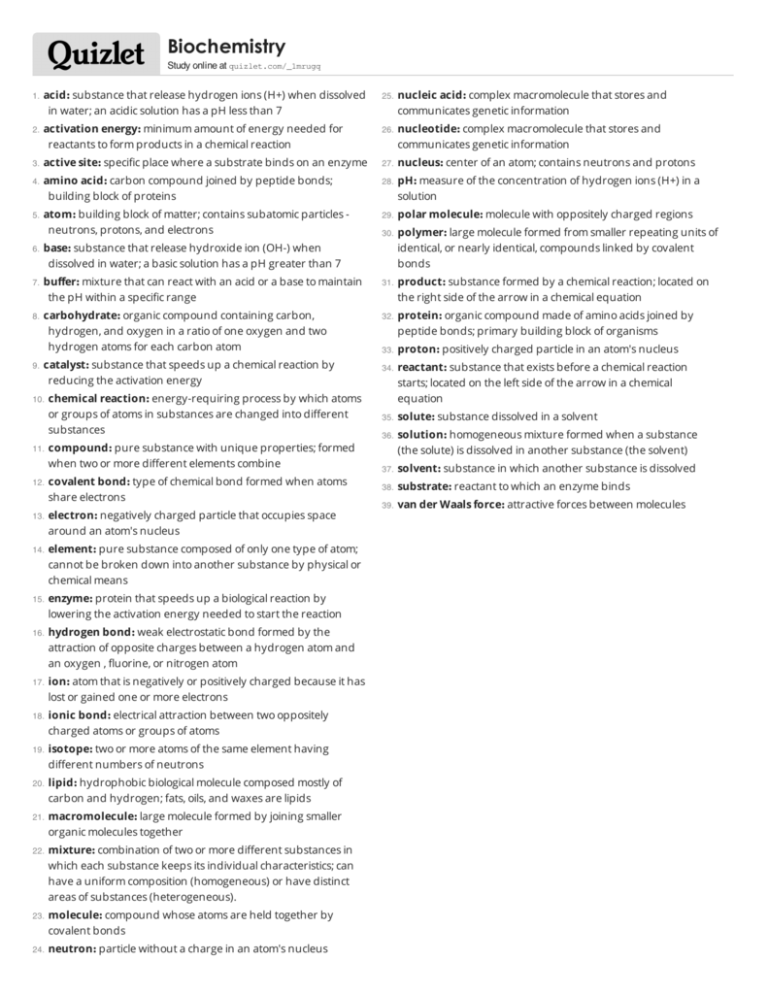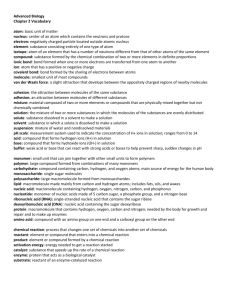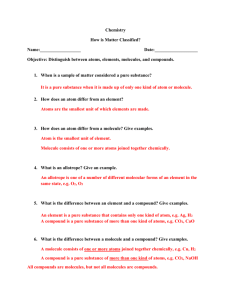Print › Biochemistry | Quizlet
advertisement

Biochemistry Study online at quizlet.com/_1mrugq 1. 2. 3. 4. 5. 6. 7. 8. 9. acid: substance that release hydrogen ions (H+) when dissolved in water; an acidic solution has a pH less than 7 activation energy: minimum amount of energy needed for reactants to form products in a chemical reaction active site: specific place where a substrate binds on an enzyme amino acid: carbon compound joined by peptide bonds; building block of proteins atom: building block of matter; contains subatomic particles neutrons, protons, and electrons 25. 26. 27. 28. 29. 30. base: substance that release hydroxide ion (OH-) when dissolved in water; a basic solution has a pH greater than 7 buffer: mixture that can react with an acid or a base to maintain the pH within a specific range carbohydrate: organic compound containing carbon, hydrogen, and oxygen in a ratio of one oxygen and two hydrogen atoms for each carbon atom catalyst: substance that speeds up a chemical reaction by reducing the activation energy 10. 11. 12. 13. 14. 15. 16. 17. 18. 19. 20. 21. 22. 23. 24. chemical reaction: energy-requiring process by which atoms or groups of atoms in substances are changed into different substances compound: pure substance with unique properties; formed when two or more different elements combine covalent bond: type of chemical bond formed when atoms share electrons electron: negatively charged particle that occupies space around an atom's nucleus element: pure substance composed of only one type of atom; cannot be broken down into another substance by physical or chemical means enzyme: protein that speeds up a biological reaction by lowering the activation energy needed to start the reaction hydrogen bond: weak electrostatic bond formed by the attraction of opposite charges between a hydrogen atom and an oxygen , fluorine, or nitrogen atom ion: atom that is negatively or positively charged because it has lost or gained one or more electrons ionic bond: electrical attraction between two oppositely charged atoms or groups of atoms isotope: two or more atoms of the same element having different numbers of neutrons lipid: hydrophobic biological molecule composed mostly of carbon and hydrogen; fats, oils, and waxes are lipids macromolecule: large molecule formed by joining smaller organic molecules together mixture: combination of two or more different substances in which each substance keeps its individual characteristics; can have a uniform composition (homogeneous) or have distinct areas of substances (heterogeneous). molecule: compound whose atoms are held together by covalent bonds neutron: particle without a charge in an atom's nucleus 31. 32. 33. 34. 35. 36. nucleic acid: complex macromolecule that stores and communicates genetic information nucleotide: complex macromolecule that stores and communicates genetic information nucleus: center of an atom; contains neutrons and protons pH: measure of the concentration of hydrogen ions (H+) in a solution polar molecule: molecule with oppositely charged regions polymer: large molecule formed from smaller repeating units of identical, or nearly identical, compounds linked by covalent bonds product: substance formed by a chemical reaction; located on the right side of the arrow in a chemical equation protein: organic compound made of amino acids joined by peptide bonds; primary building block of organisms proton: positively charged particle in an atom's nucleus reactant: substance that exists before a chemical reaction starts; located on the left side of the arrow in a chemical equation solute: substance dissolved in a solvent solution: homogeneous mixture formed when a substance (the solute) is dissolved in another substance (the solvent) 37. solvent: substance in which another substance is dissolved 38. substrate: reactant to which an enzyme binds 39. van der Waals force: attractive forces between molecules








